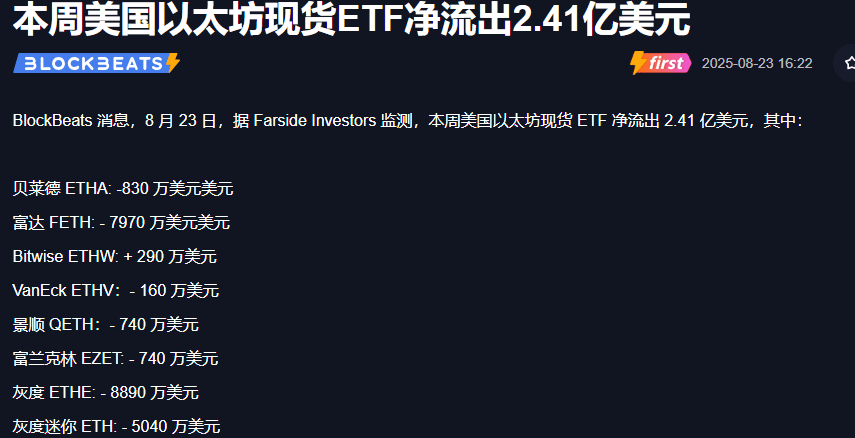Last night, Fed Chairman Powell's dovish remarks injected a strong dose of confidence into the risk market, causing the cryptocurrency market to surge. However, within this broad increase, a clear divergence appeared: Ethereum surged forward, reaching a historical high of $4,888; while Bitcoin struggled at $117,400, failing to break through the $120,000 mark.
This 'strong ETH, weak BTC' situation is not accidental but is determined by the current market's unique capital flow, investor preferences, and fundamental factors.
The most direct reason: funds are flowing out of BTC ETFs and wildly pouring into ETH ETFs.

This is the most core and direct reason for the divergence in their trends.
BTC Spot ETF: Unexpected net outflow, giant BlackRock faced significant redemptions.
Despite the macro positives, yesterday the overall net outflow from the US Bitcoin spot ETF was $23.2 million. This itself is an extremely bearish signal, indicating that at price peaks, investors are more inclined to take profits rather than chase prices.
The key to the key: The market's biggest stabilizing force—BlackRock's IBIT, saw a daily net outflow of $198.8 million. This is an extremely rare large net outflow since IBIT's listing, and the giant's selling pressure heavily suppressed BTC's upward price space.
Although other ETFs like Fidelity and ARK have seen inflows, they cannot offset the massive outflows caused by BlackRock. This indicates that investment institutions or large holders are withdrawing funds from BTC, this 'traditional' crypto asset.
ETH Spot ETF: Continuous crazy net inflow, significant capital siphoning effect
In contrast, the US Ethereum spot ETF saw a net inflow of up to $337 million yesterday, with its scale breaking the $30 billion mark for the first time, indicating extremely strong market demand.
Giants moving forward together: BlackRock and Fidelity, two major giants, had net inflows of $109 million and $118 million respectively. The funds are not leaving the giant products but are shifting from BlackRock's BTC product to BlackRock's ETH product. This 'intra-family asset swap' is significant.
The huge net inflow created a strong buying pressure, directly pushing up ETH prices and successfully capturing the market's full attention.
Deep reasons: The shift in market narratives and investor behavior
Behind the capital flow is a short-term shift in market narratives and investor preferences.
"Asset swap narrative" became the market focus: The whale activity you provided perfectly corroborates this. A whale/institution holding 10,606 BTC with a profit of $1.1 billion chose to sell 300 BTC and swap into ETH. This whale has now established a massive ETH long and spot position, with unrealized gains exceeding $100 million. This behavior sends a strong signal to the market: even the most loyal long-term BTC holders are currently more optimistic about ETH's short-term performance and potential. This 'sell BTC, buy ETH' asset swap transaction is an important force suppressing BTC prices and pushing up ETH prices.
The 'staking yield' narrative of ETH: Against the backdrop of macro dovishness, seeking yield has become an important goal for investors. Holding ETH can generate yield through staking, while holding BTC does not have this native yield function. The ETH spot ETF itself may also bring staking yields to investors, making it more attractive to traditional financial investors, like a 'yield-generating asset'.
Technical breakthroughs and FOMO sentiment: ETH successfully broke through its previous high and set a new historical high, thoroughly igniting the market's FOMO sentiment. A historical high means that investors at all stages are in a profitable state, with no historical trapped positions, resulting in less upward resistance. Meanwhile, BTC is still far from its historical peak, and in the face of the critical psychological threshold of $120,000, investors tend to be cautious and take profits.
"Awakening whale" selling pressure: Another piece of news about a whale transferring 3,500 BTC after three years of dormancy, although its purpose for selling is not yet clear, such movements from long-term holders typically bring potential selling expectations and psychological pressure to the market, further suppressing bullish sentiment for BTC.
In summary, last night's market was a typical case of 'sector rotation' and 'capital siphoning'.
Powell's dovish remarks provided ample liquidity to the market, but this 'water' did not flow evenly to all assets. With the emergence of the powerful new financial tool of ETH ETF, along with its inherent yield characteristics and the FOMO effect brought about by technological breakthroughs, funds have been more concentrated in ETH. Meanwhile, some investors chose to sell the already significantly appreciated BTC to raise funds for ETH investments, creating strong selling pressure from asset swaps.
Therefore, BTC is not 'dead', but at this stage, the market's momentum, hot money, and narrative are completely dominated by ETH. BTC's weakness is relatively weak and is a result of short-term selective fund preferences. Once the enthusiasm for ETH subsides, or if BTC itself sees new catalysts, funds are likely to flow back, and the dynamics between the two will change accordingly.



